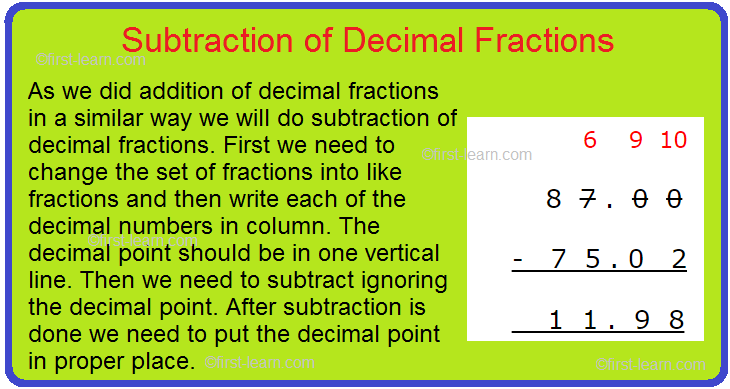Subtraction of Decimal Fractions
This topic will deal with subtraction of decimal fractions. As we did addition of decimal fractions in a similar way we will do subtraction of decimal fractions. First we need to change the set of fractions into like fractions and then write each of the decimal numbers in column. The decimal point should be in one vertical line. Then we need to subtract ignoring the decimal point. After subtraction is done we need to put the decimal point in proper place.
For example:
Subtract 75.02 from 87
First change the two decimal numbers into like fraction
75.02 and 87.00
6 9 10
8 7 . 0 0
- 7 5 . 0 2
1 1 . 9 8
In the hundredths place we cannot subtract 2 from 0 and hence needs to borrow 1 from tenths place. But there is 0 in the tenths place and hence need to borrow 1 from units place to make the number in tenths place 10 and it will lend 1 from it to hundredths place and hence would become 9. Now in the hundredths place 2 can be subtracted from 10 after borrowing. In the hundredths place 0 can be subtracted from 9 to get 9.
The number in the units place is now 6 after lending. However 5 can be subtracted from 6 to get 1 and lastly in tens place 7 can be subtracted from 8 to get 1.
Here are few other examples on subtraction of decimals
1. Subtract 400.23 from 684. 9
Solution:
First change the two decimal numbers into like fraction
400.23 and 684.90
8 10
6 8 4 . 9 0
- 4 0 0 . 2 3
2 8 4 . 6 7
In this subtraction in hundredths place 3 cannot be subtracted from 0 hence we borrowed 1 from the 9 in the tenths place. Now in the hundredths place 3 is subtracted from 10 to get 7. Moreover, now in the tenths place 2 is subtracted from 8 to get 6. There is no need of borrowing in the integral part. In the hundredths place 0 subtracted from 4 is 4. In tens place 0 subtracted from 8 is 8 and in the hundreds place 4 subtracted from 6 is 2.
2. Subtract 854.87 from 990.97
Solution:
8 10
9 9 0 . 9 7
- 8 5 4 . 8 7
1 3 6 . 1 0
In this subtraction there is no need of borrowing in the fractional part and hence 7 subtracted from 7 is 0 in the hundredths place and then 8 subtracted from 9 is 1 in the tenths place. In the units place 4 cannot be subtracted from 0 and hence need to borrow 1 from tens place to make it 10. Now 4 subtracted from 10 is 6. We have borrowed 1 from 9 in the tens place. So, now we have to subtract 5 from in the tens place to get 3 and finally in the hundreds place 8 subtracted from 9 is 1.
From Subtraction of Decimal Fractions to HOME PAGE
Recent Articles
-
What Is Plasma? | Blood Plasma | Proteins | Nutrients | Cholesterol
Nov 07, 25 10:29 AM
Blood is a mobile fluid which is a connective tissue and is derived from the mesoderm like cell any other connective tissue. Colour of blood is reddish and that flows inside the blood vessels by means… -
Disorders of Respiratory System | Tuberculosis | Pleurisy | Emphysema
Oct 28, 25 11:39 PM
Tuberculosis is very common disease and is caused by a type of bacteria called Mycobacterium tuberculosis. This disease causes different trouble in the respiration and infection of several parts of th… -
Regulation of Respiration | Respiratory Centres | Inspiratory Area |
Oct 14, 25 12:13 AM
Respiratory Centre is the area that controls the rate of respiration and it is observed to be located in medulla oblongata and pons. Respiratory Centre has the following will dispersed components like… -
Explain Transport of Gases | External Respiration | Tissue Respiration
Oct 09, 25 11:35 PM
In humans gaseous exchange is completed in the following ways the steps are - External Respiration or Breathing - Breathing in false taking in of Oxygen and giving out of carbon dioxide in the body. M… -
Kind and Number of Teeth | Location of Teeth in Mouth | Care of Teeth
Sep 11, 25 12:52 AM
Kind and Number of Teeth







New! Comments
Have your say about what you just read! Leave me a comment in the box below.